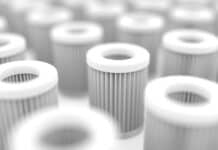By Brie Welzer
At Green Seal, we often hear the question: how do I know green cleaning products work as effectively as conventional ones? With coronavirus prompting more frequent use of cleaning products (and more inhalation of cleaning chemicals), here’s a window into Green Seal’s performance requirements for certified green cleaning products.
Defining Clean
Amid the coronavirus epidemic, it is important to remember that proper cleaning is a critical first step in the disinfecting process. Disinfectants are less effective when applied directly to dirty surfaces because germs can hide behind bits of dirt.
To clean is to remove visible soil from objects and surfaces where germs can hide. How you measure effectiveness depends on the kind of surface you’re trying to clean.
Shortly after launching, Green Seal worked together with hundreds of cleaning industry and public health experts to agree on how to evaluate the effectiveness of cleaning products in a way that can be tested in lab—so we can clearly see what works and what doesn’t work.
For example, glass cleaners should be able to remove toothpaste splatters and hairspray from your bathroom mirror while avoiding leaving behind unsightly smears and streaks.
Carpet cleaners should be able to remove dirt and stains and to avoid re-soiling—which is where soapy, sticky residue from the cleaner ends up attracting more soil and dirt.
And general-purpose cleaners, like the kind used on kitchen counters, should be able to remove a minimum of 80% of dirt from a surface.
If It Doesn’t Work, It’s Won’t Be Certified by Green Seal
A foundational belief at Green Seal is that a product is not green if it doesn’t work as consumers expect it to. The odds are that an under-performing product will be thrown away and replaced with one that works better — which is a terrible waste of resources. All of our standards include strict performance requirements so that consumers can be confident that Green Seal-certified products are proven-healthier and proven as effective as conventional alternatives.
When it comes to performance, not all certifications are created equal. Purchasers and consumers should always check whether a certification body includes performance requirements in its standard.
Green Seal’s Testing Requirements
Before achieving Green Seal certification, general purpose cleaners are rigorously tested and re-tested to prove that they can successfully and consistently remove dirt and grime from surfaces.
How does this test work? Green Seal requires testing based on a nationally developed method for evaluating cleaning products. The standard, from ASTM (formerly known as the American Society for Testing and Materials), details the steps to take to evaluate a cleaner’s efficacy in removing test soil from white vinyl tiles. This test method was not specially designed for green cleaning products—many conventional cleaners have been tested this way as well.
The standard provides a recipe for the test soil, which acts as a stand-in for dirt that most of us encounter in real life. The recipe includes ingredients such as natural humus (organic material that includes decayed leaf litter), used motor oil, iron oxide (rust), kerosene, vegetable shortening, and olive oil.
First, a set amount of the test soil is applied to vinyl floor tiles and air dried for 24 hours. Then, a fresh sponge that has been soaked with the cleaning solution is attached to the cleaning apparatus, which scrubs the tile exactly 10 times at the same applied pressure. Next, the tile is rinsed off with water.
The amount of soil removed is determined by using a reflectometer that measures light reflected off of the tile (0=black, 100=white). The more light that is reflected, the cleaner the tile. Each tile is measured three times and the average is used as the final cleaning score.
This process is repeated with at least three different sets of tiles and sponges. The cleaning product must receive an average score of 80% soil removal to be considered effective and to qualify for Green Seal certification.
Learn More
For more information about proper cleaning and disinfecting, visit the EPA and the CDC for guidance preventing coronavirus in your home or building. You can also find Green Seal’s blog on safely disinfecting for coronavirus here, including a curated list of some of the safest EPA-registered disinfectants.
Welzer is Standards Program Manager, Environmental Scientist at Green Seal, where she supports the development of new standards, manages the revisions of issued standards, conducts sustainability analyses, and leads science communications initiatives. Prior to joining Green Seal, Brie provided mission and research support to the U.S. EPA and managed innovative programs in partnership with the American Association for the Advancement of Science (AAAS). She graduated with a B.S. in Environmental Science and Geochemistry from the University of Rochester, and has an M.B.A. in Sustainable Business.
Want to learn more about Cleaning topics?
Check out all the latest facility management news related to Cleaning.




















![[VIDEO] Collect Asset Data at the Speed of Walking a Building](https://facilityexecutive.com/wp-content/uploads/2024/02/maxresdefault-324x160.jpg)